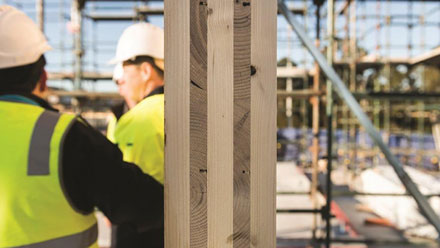
CLT is made up by blueing lamellas together in alternating directions.
Few, if any, construction projects on an Oregon campus have undergone the kind of scrutiny that Oregon State University’s Peavy Hall has faced. But then again, few projects are carrying the load that Peavy Hall has shouldered. Source: Democrat Herald
Not only is the new building intended to be the home of OSU’s College of Forestry, it also is intended to showcase a technology that could help revitalize the state’s wood-products industry.
Peavy was meant (and still is meant) to be a poster project for the use of cross-laminated timber panels, glulam columns and other engineered wood products rather than steel and concrete for structural support. It hasn’t worked out that way thus far for Peavy, the centerpiece of a planned three-building Oregon Forest Science Complex.
The project has been dogged by controversy from the start: Some students and faculty in the College of Forestry say that the original Peavy Hall, which was torn down in 2016, could have been renovated for far less than the cost of a new building.
The budget for the entire Forest Science Complex has ballooned from $60 million to $79.5 million.
The building was meant to be ready in the fall of 2017, but that timeline has been repeatedly modified amid rising construction costs and other issues. Just last week, this newspaper reported about yet another delay.
OSU officials now hope to open the building in the fall of 2019.
Worse, a construction accident has fueled worries about the very cross-laminated timber products that Peavy was meant to showcase, even though those products have been in use in Europe for more than two decades.
On March 14, part of a 4-foot-by-20-foot section of CLT subflooring on the third floor of Peavy buckled and tumbled onto the floor below. No one was injured when the 1,000-pound sheet of wood fell.
OSU and builders immediately hit the pause button on the project to determine what went wrong. The issue was traced to a glitch in the manufacturing process at the DR Johnson mill in Riddle, where preheating of 2-by-6 boards resulted in improper curing of adhesives holding the cross-laminated layers of wood together.
The situation was quickly corrected by the manufacturer, but CLT panels that had already been installed had to be evaluated for potential problems. To date, OSU officials said, 40 faulty panels have been replaced and another 45 have been identified for replacement. Others are still being evaluated for safety.
OSU remains committed to the use of CLT panels in the complex. OSU Vice President Steve Clark, in a story about Peavy that recently ran in The Oregonian, said he preferred to think about the setbacks “as a learning moment that we hope will never happen again.”
But the Peavy affair has opened a window for CLT skeptics.
“The OSU building is a godsend,” The Oregonian quoted an official with the Portland Fire Fighters’ Union as saying. “They found a defect. Now, they need to take a break and listen to all the stakeholders.”
In fact, firefighters — worried that CLT structures might be more susceptible to flames than traditional concrete-and-steel structures — have signaled opposition to plans to build skyscrapers with the panels.
And plans to build a 12-story skyscraper in Portland and a similar structure in Manhattan have been scrapped. So, you can bet Peavy will be the center of attention as construction resumes on the complex.
“You’ve got a new product coming on line and the last thing you need is a failure,” said a consultant quoted by The Oregonian. “You just can’t afford any black eyes early in the development.”
Now, the question of whether CLT and similar techniques can truly help to revitalize Oregon’s wood-products industry may hinge on whether Peavy can shake off that shiner.
That healing requires OSU to be as open as possible about Peavy’s progress — and any additional issues — for the rest of the construction period and after it opens its doors.







